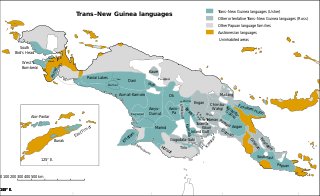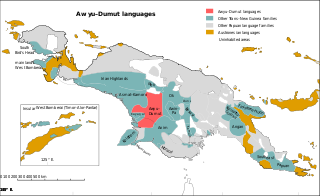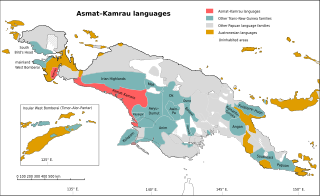Related Research Articles

Trans–New Guinea (TNG) is an extensive family of Papuan languages spoken on the island of New Guinea and neighboring islands, a region corresponding to the country Papua New Guinea as well as parts of Indonesia.

The Papuan languages are the non-Austronesian languages spoken on the western Pacific island of New Guinea, as well as neighbouring islands in Indonesia, Solomon Islands, and East Timor by around 4 million people. It is a strictly geographical grouping, and does not imply a genetic relationship.
The Sko or Skou languages are a small language family spoken by about 7000 people, mainly along the Vanimo coast of Sandaun Province in Papua New Guinea, with a few being inland from this area and at least one just across the border in the Indonesian province of Papua.
The Ramu–Lower Sepika.k.a.Lower Sepik–Ramu languages are a proposed family of about 35 Papuan languages spoken in the Ramu and Sepik river basins of northern Papua New Guinea. These languages tend to have simple phonologies, with few consonants or vowels and usually no tones.

The Greater Awyu or Digul River languages, known in earlier classifications with more limited scope as Awyu–Dumut (Awyu–Ndumut), are a family of perhaps a dozen Trans–New Guinea languages spoken in eastern West Papua in the region of the Digul River. Six of the languages are sufficiently attested for a basic description; it is not clear how many of the additional names may be separate languages.

The Asmat – Kamrau Bay languages are a family of a dozen Trans–New Guinea languages spoken by the Asmat and related peoples in southern Western New Guinea. They are believed to be a recent expansion along the south coast, as they are all closely related, and there is little differentiation in their pronouns.
The Pauwasi languages are a likely family of Papuan languages, mostly in Indonesia. The subfamilies are at best only distantly related. The best described Pauwasi language is Karkar, across the border in Papua New Guinea. They are spoken around the headwaters of the Pauwasi River in the Indonesian-PNG border region.

The Teberan languages are a well established family of Papuan languages that Stephen Wurm (1975) grouped with the Pawaia language as a branch of the Trans–New Guinea phylum.

The Kamula–Elevala languages are a small family of the Trans–New Guinea languages spoken in the region of the Elevala River.

The Mombum languages, also known as the Komolom or Muli Strait languages, are a pair of Trans–New Guinea languages, Mombum (Komolom) and Koneraw, spoken on Komolom Island just off Yos Sudarso Island, and on the southern coast of Yos Sudarso Island, respectively, on the southern coast of New Guinea. Komolom Island is at the southern end of the Muli Strait.

The Finisterre–Huon languages comprise the largest family within the Trans–New Guinea languages (TNG) in the classification of Malcolm Ross. They were part of the original TNG proposal, and William A. Foley considers their TNG identity to be established. The languages share a small closed class of verbs taking pronominal object prefixes some of which are cognate, strong morphological evidence that they are related.
The Demta–Sentani languages form a language family of coastal Indonesian Papua near the Papua New Guinea border.
Telefol is a language spoken by the Telefol people in Papua New Guinea, notable for possessing a base-27 numeral system.
Central Asmat is a Papuan language of West New Guinea, spoken by the Asmat people.
Apalɨ (Apal), or Emerum, is a Papuan language of Madang Province, Papua New Guinea. Akɨ and Acɨ are two dialects that are quite different from each other.
Selepet (Selepe) is a Papuan language spoken in Selepet Rural LLG, Morobe Province, Papua New Guinea.
Binandere is a Papuan language spoken in the "tail" of Papua New Guinea.
Mandobo, or Kaeti, is a Papuan language of Mandobo District in Boven Digoel Regency, South Papua, Indonesia.

The Asmat–Muli Strait languages are a branch of the Trans–New Guinea languages spoken along the southern coast of Indonesian New Guinea, established by Timothy Usher and Edgar Suter.
Proto-Trans–New Guinea is the reconstructed proto-language ancestral to the Trans–New Guinea languages. Reconstructions have been proposed by Malcolm Ross and Andrew Pawley.
References
- ↑ Usher, Timothy; Suter, Edgar (2020). "The Asmat-Muli Languages of Southwestern New Guinea" (PDF). Language & Linguistics in Melanesia. Port Moresby: Journal of the Linguistic Society of Papua New Guinea. 38. ISSN 0023-1959.
- ↑ New Guinea World, Kamrau Bay
- ↑ Pawley, Andrew (2012). Hammarström, Harald; van den Heuvel, Wilco (eds.). "How reconstructable is proto Trans New Guinea? Problems, progress, prospects". History, Contact and Classification of Papuan Languages. Port Moresby, Papua New Guinea: Linguistic Society of Papua New Guinea (Language & Linguistics in Melanesia Special Issue 2012: Part I): 88–164. hdl:1885/38602. ISSN 0023-1959.
- ↑ Foley, William A. (2018). "The morphosyntactic typology of Papuan languages". In Palmer, Bill (ed.). The Languages and Linguistics of the New Guinea Area: A Comprehensive Guide. The World of Linguistics. Vol. 4. Berlin: De Gruyter Mouton. pp. 895–938. ISBN 978-3-11-028642-7.